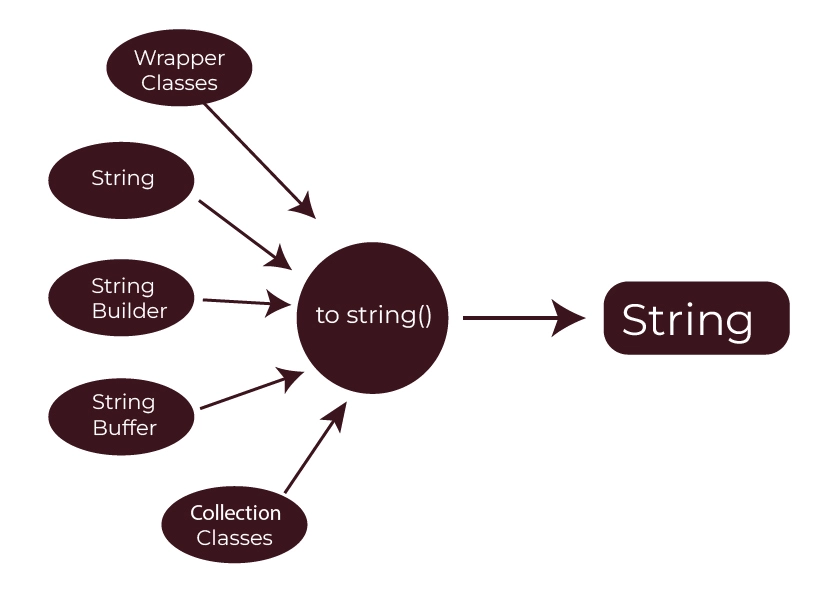The ‘toString’ method in Java is essential to the Java programming language. It is widely used for converting objects into a string representation. The ‘toString’ method is defined in the Object class. The Object class is the superclass of all the sub-classes, meaning every object in Java has access to the ‘toString’ method. This article explained the toString method.
What is toString() Method in Java
The toString() method is the built-in method in Java. That provides a string representation of an object. The toString() method is quite useful in that it allows string representations of objects. It can be useful during debugging, logging, and displaying information about the objects as human-readable text.
The following program demonstrates the toString() method:
Program
class Account {
private String accountHolderName;
private int accountNumber;
private double balance;
public Account(String accountHolderName, int i, double balance) {
this.accountHolderName = accountHolderName;
this.accountNumber = i;
this.balance = balance;
}
@Override
public String toString() {
return "Account{" +
"Account Holder: '" + accountHolderName + '\'' +
", Account Number: '" + accountNumber + '\'' +
", Balance: $" + balance +
'}';
}
}
class Main{
public static void main(String args[ ]){
Account ob = new Account("Neeraj Kumar",33435 , 159.5) ;
System.out.println(ob.toString());
}
}
Output
Account{Account Holder: 'Neeraj Kumar', Account Number: '33435', Balance: $159.5}

POSTGRADUATE PROGRAM IN
Multi Cloud Architecture & DevOps
Master cloud architecture, DevOps practices, and automation to build scalable, resilient systems.
Override the toString() method in Java
Overriding the ‘toString()’ method in Java allows you to define a custom string representation for an object. The detailed explanation and example of “how to override the ‘toString()’ method in Java.
The following program demonstrates the toString() method:
Program:
class Student {
String name ;
int age ;
Student(String name, int age){
this.name = name ;
this.age = age ;
}
public String toString(){
return "Student{" + "Name ='" + name + '\'' + ", Age=" + age + '}';
}
}
class Main{
public static void main(String args[]){
Student ob = new Student("Anupriya", 23) ;
System.out.println("Output"+ob) ;
}
}
Output
OutputStudent{Name ='Anupriya', Age=23}
Java Classes with toString() Overridden by Default

In Java, All the wrapper classes like Byte, Integer, Long, Float, Double, Boolean, and Character have overridden the toString() method. The collection classes, such as String and StringBulder, have also overridden the toString() method.
Source Code:
import java.util.*;
class Main{
public static void main(String args[]){
System.out.println(" toString Method Example in Java ");
Integer integer = 55 ;
String name = "Neeraj Kumar" ;
List<String> cities = new ArrayList<>() ;
cities.add("France") ;
cities.add("Kolkata") ;
cities.add("Mumbai Watermellon") ;
System.out.println(integer);
System.out.println(name) ;
System.out.println(cities) ; // System.out.println() method by default uses toString() method internally
}
}
Output
55
Neeraj Kumar
[France, Kolkata, Mumbai Watermellon]
Using static toString() method in Wrapper Classes
The Wrapper classes in Java implement the ‘toString()’ method statically. We can directly get the String value without defining an object of the class.
The following program demonstrates the toString() method:
Program
public class Main {
public static void main(String args[]){
String representation = Integer.toString(3344) ;
System.out.println(representation);
System.out.println(representation.getClass());
}
}
Output
3344
class java.lang.String

82.9%
of professionals don't believe their degree can help them get ahead at work.
Using valueOf() Method in String Class
The valueOf() method in the ‘String’ class is a versatile utility in Java that converts different data types into their corresponding ‘String’ representation. This method is particularly useful when converting primitive data types, objects, or arrays into a ‘String’.
The following program demonstrates the valueOf() method in Java:
class Main{
public static void main(String args[]){
String representation = String.valueOf(533.3) ;
System.out.println(representation);
}
}
Output
533.3
Best Practices for Overriding ‘toString()’
Let’s see some best practices for overriding the method.
- Keep it Simple: The string method should be simple and informative. That must include only the essential information that defines the object.
- Avoid Sensitive Information: Developers must not include sensitive data like passwords or personal information.
- Use StringBuilder: It performs better, especially when concatenating multiple strings. Use ‘StringBuilder’ instead of ‘+’ for string concatenation.
- Ensure Readability: The output of the ‘toString()’ method should be easily readable and understandable to the person who will see it.
- Improved Readability: For complex objects, especially in large applications, a well-defined ‘toString()’ method helps make the output more human readable. This is particularly useful for developers who are working with or maintaining the source code.
Conclusion
Java’s ‘toString()’ method is fundamental for converting objects into a human-readable string format. By overriding this method, you can customize how objects are represented as strings, enhancing the clarity and usefulness of the output whether working with custom classes, wrapper classes, or using the ‘valueOf()’ method in the ‘String’ class, understanding and effectively implementing ‘toString()’ will improve your code’s readability and debugging process.
How does ‘toString()’ affect debugging?
Is it possible to use ‘toString()’ in static contexts?
Can the ‘toString()’ method be used for logging purposes?
Can I include the values of instance variables in the ‘toString()’ method?
Does ‘toString()’ affect object equality?
Updated on August 30, 2024
